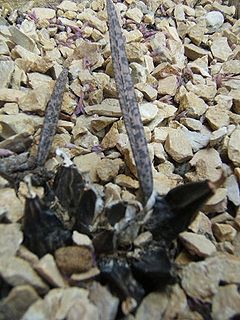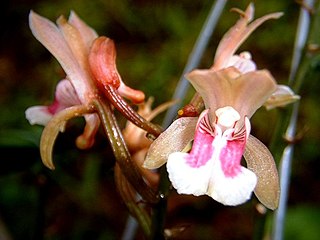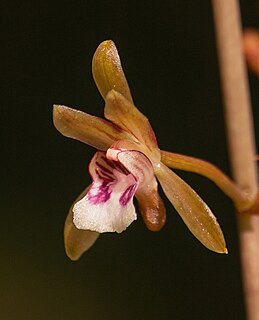
Oeceoclades decaryana is a terrestrial orchid species of the genus Oeceoclades that is native throughout southern and southeastern Africa. It can be found growing in Kenya, Mozambique, Zimbabwe, Madagascar, and KwaZulu-Natal in South Africa. It was first described by the French botanist Joseph Marie Henry Alfred Perrier de la Bâthie in 1935 as a species in the genus Eulophia. He later transferred this species to the genus Lissochilus in 1941, followed by another transfer to the genus Eulophidium in 1957 by the English botanist V.S. Summerhayes in 1957. When Leslie Andrew Garay and Peter Taylor revised the genus Oeceoclades in 1976, they transferred this species to the expanded Oeceoclades.

Jean Marie Bosser, sometimes listed as Jean-Michel Bosser was a French botanist and agricultural engineer who worked extensively in Madagascar and Mauritius.

Oeceoclades maculata, sometimes known as the monk orchid or African spotted orchid, is a terrestrial orchid species in the genus Oeceoclades that is native to tropical Africa and now naturalized in South and Central America, the Caribbean, and Florida in North America. It was first described by the English botanist John Lindley as Angraecum maculatum in 1821 based on a specimen collected from South America. Lindley later revised his original placement and moved the species to the genus Oeceoclades in 1833.

Oeceoclades gracillima, sometimes known in horticulture by the synonym Oeceoclades roseovariegata, is a terrestrial orchid species in the genus Oeceoclades that is endemic to Madagascar. It was first described by the German botanist Rudolf Schlechter under the illegitimate name Eulophia gracillima in 1913. Schlecter later validly republished the species under the name Eulophidium gracillimum in 1925. It was then moved to the genus Oeceoclades by Leslie Andrew Garay and Peter Taylor in 1976.
Oeceoclades ambongensis is a terrestrial orchid species in the genus Oeceoclades that is endemic to Madagascar. It was first described by the German botanist Rudolf Schlechter in 1913 as Eulophidium ambongense. When Leslie Andrew Garay and Peter Taylor revised the genus Oeceoclades in 1976, they transferred this species to the expanded Oeceoclades as O. ambongensis. Garay and Taylor noted that this species could be distinguished from closely allied species, such as O. maculata by its larger flowers with subglobose spur and a bilobed callus on the labellum.
Oeceoclades analamerensis is a terrestrial orchid species in the genus Oeceoclades that is endemic to northern Madagascar. It was first described by the French botanist Joseph Marie Henry Alfred Perrier de la Bâthie in 1939 as Lissochilus analamerensis. The English botanist V.S. Summerhayes later transferred this species to the genus Eulophidium in 1957. When Leslie Andrew Garay and Peter Taylor revised the genus Oeceoclades in 1976, they transferred this species to the expanded Oeceoclades.
Oeceoclades analavelensis is a terrestrial orchid species in the genus Oeceoclades that is endemic to southwestern Madagascar. It was first described by the French botanist Joseph Marie Henry Alfred Perrier de la Bâthie in 1939 as Lissochilus analavelensis. The English botanist V.S. Summerhayes later transferred this species to the genus Eulophidium in 1957. When Leslie Andrew Garay and Peter Taylor revised the genus Oeceoclades in 1976, they transferred this species to the expanded Oeceoclades.
Oeceoclades lubbersiana is a terrestrial orchid species in the genus Oeceoclades that is native to the Democratic Republic of the Congo and Uganda. It was first described by the Belgian botanists Émile Auguste Joseph De Wildeman and Émile Laurent in 1899 as Eulophia lubbersiana, then moved to the genus Eulophidium by V.S. Summerhayes in 1957 and again transferred to the genus Oeceoclades in 1976 by Leslie Andrew Garay and Peter Taylor. Garay and Taylor noted that this species is similar to O. atrovirens in vegetative morphology, but is better allied to O. latifolia and O. pandurata because all three possess a labellum that is wider than it is long. Oeceoclades lubbersiana was named in honor of Louis Lubbers, who was a botanist working at the Botanical Garden of Brussels.
Oeceoclades petiolata is a terrestrial orchid species in the genus Oeceoclades that is endemic to northern and western Madagascar. It was first described by the German botanist Rudolf Schlechter in 1913 as Eulophia petiolata. Schlechter later moved this species to the genus Eulophidium in 1925. It was again moved to the genus Lissochilus by the French botanist Joseph Marie Henry Alfred Perrier de la Bâthie in 1941 and last transferred the genus Oeceoclades in 1976 by Leslie Andrew Garay and Peter Taylor. Garay and Taylor noted that this species is almost identical to O. alismatophylla in vegetative morphology, but the two differ in the shape of the labellum on the flower. The labellum is fiddle-shaped and has three thickened veins in front of the calli.
Oeceoclades quadriloba is a terrestrial orchid species in the genus Oeceoclades that is native to Swaziland, southern Zimbabwe, and western Madagascar. It was first described by the German botanist Rudolf Schlechter in 1913 as Eulophia quadriloba. Schlechter later moved this species to the genus Eulophidium in 1925. It was again moved to the genus Lissochilus by the French botanist Joseph Marie Henry Alfred Perrier de la Bâthie in 1941 and last transferred the genus Oeceoclades in 1976 by Leslie Andrew Garay and Peter Taylor. Garay and Taylor noted that structure of the labellum is unique in the genus and resembles that of an Asian genus of orchids, Grosourdya. The spur is longer than the midlobe of the labellum.
Oeceoclades ambrensis is a terrestrial orchid species in the genus Oeceoclades that is endemic to northern Madagascar, where it grows in humid forests at altitudes of 1,000–1,100 metres (3,300–3,600 ft). It was first described by the French botanist Joseph Marie Henry Alfred Perrier de la Bâthie in 1951 as Lissochilus ambrensis and moved to the genus Eulophia in 1975 by Friedhelm Reinhold Butzin. It was last transferred to the genus Oeceoclades in 2001 by Jean Marie Bosser and Philippe Morat. The type specimen was collected in 1924 from montagne d'Ambre, now a part of Amber Mountain National Park. The pseudobulbs are fusiform (spindle-shaped) and homoblastic. Oeceoclades ambrensis is most similar to O. pulchra but it differs in the structure of the labellum, having rounded lobes.
Oeceoclades humbertii is a terrestrial orchid species in the genus Oeceoclades that is endemic to southeastern Madagascar, where it grows in xerophilous bush at altitudes from 500 to 600 m. It was first described by the French botanist Joseph Marie Henry Alfred Perrier de la Bâthie in 1939 as Lissochilus humbertii and moved to the genus Eulophia in 1975 by Friedhelm Reinhold Butzin. It was last transferred to the genus Oeceoclades in 2001 by Jean Marie Bosser and Philippe Morat. The type specimen was collected from the left bank of the Manambolo valley in the Mandrare River basin in either December 1933 or January 1934 when it was recorded as flowering by its collector Jean-Henri Humbert for whom the specific epithet humbertii honors. The small pseudobulbs are conical and heteroblastic. Oeceoclades humbertii is distinguished from all other Oeceoclades by its completely green flowers. It has only been collected twice including the type specimen; the other specimen was collected by Philippe Morat in 1973 from the Onilahy valley in the Ankazoabo gorges north of Betioky.
Oeceoclades longebracteata is a species of terrestrial orchid in the genus Oeceoclades that is endemic to southwestern and south-central Madagascar. It was first described by the French botanists Jean Marie Bosser and Philippe Morat in 2001. The type specimen was collected in 1970 by Jean Marie Bosser from dry forest undergrowth near Tsaramasao, 20 km (12 mi) south of Sakaraha. The specific epithet longebracteata refers to the long bracts found along the inflorescence.
Oeceoclades peyrotii is a species of terrestrial orchid in the genus Oeceoclades that is endemic to southwestern Madagascar. It was first described by the French botanists Jean Marie Bosser and Philippe Morat in 2001. The type specimen was collected in 1974 by Bosser and Morat from the woods near Ankazoabo, but it has also been found 40 km (25 mi) south of Sakaraha, near Mahaboboka, and near Morombe. The specific epithet peyrotii was given to this species in honor of Dr. Jean-Pierre Peyrot whose observations and collections have led to a better understanding of Malagasy orchids.
Oeceoclades antsingyensis is a terrestrial orchid species in the genus Oeceoclades that is endemic to western Madagascar. It was first described by Günter Gerlach in 1995. The type specimen was collected approximately 13 km (8.1 mi) west of Antsalova.
Oeceoclades aurea is a terrestrial orchid species in the genus Oeceoclades that is endemic to Madagascar. It was first described by Xavier Garreau de Loubresse in a 1994 issue of the French orchid society journal Orchidée.
Oeceoclades callmanderi is a species of terrestrial orchid in the genus Oeceoclades that is endemic to northeastern Madagascar, where it grows in the coastal forests of Cape Masoala. It was first described by the French botanist Jean Marie Bosser in 2006 and named in honor of one of the collectors, M. W. Callmander.
Oeceoclades versicolor is a terrestrial orchid species in the genus Oeceoclades that is endemic to Réunion in the Indian Ocean. In 1880, the French botanist Charles Frappier published a list of 145 orchids that grew on the island of Réunion, but Frappier died before he could complete his studies and formally describe all of the species. Frappier's work was continued by Eugène Jacob de Cordemoy and in his 1895 work "Flore de l'île de La Réunion", he described Eulophia versicolor and attributed the name to Frappier, although the name did not appear on the 1880 list of Réunion's orchids.
Aloe castilloniae is a species of flowering plant in the family Asphodelaceae. It is endemic to the south of Madagascar, where it grows in calcareous cliffs and rocky ridges in the Mahafaly plateau.





